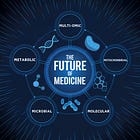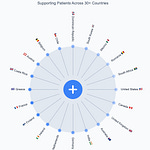The Rejuvenation Olympics sound like a great way to gamify health, but what if we’re incentivizing short-sighted behaviors at the cost of long-term health?
The research is compelling—studies consistently link grip strength to lower risks of cancer, heart disease, and all-cause mortality. It's dirt cheap to test, takes seconds to perform, and the correlation with health outcomes is remarkable.
Sounds like a no-brainer, right? Improve your grip strength, live longer. But here's the catch.
When Measures Become Targets
Goodhart's Law states, "When a measure becomes a target, it ceases to be a good measure." If we chase grip strength alone, we're unlikely to achieve the health outcomes we desire.
This is the same trap educators fall into with standardized testing. When schools start teaching to the test, test scores might improve while actual learning stagnates or even declines. Students become proficient at test-taking strategies without developing critical thinking skills or deep subject knowledge. The metric improves, but the underlying goal of better education suffers.
Grip strength works the same way. It's an excellent biomarker because it reflects multiple interconnected aspects of health: total muscle mass and bone density, tendon stiffness and joint health, nervous system coordination, and perhaps most importantly, an overall active lifestyle.
People with strong grips don't just have strong hands—they tend to move more, lift more, and eat better. Good grip strength isn't the cause of their health. It's the side effect. Healthier people naturally test higher on any measure of physical fitness, from VO2 max to resting heart rate. Focusing on a single metric can fool us into thinking that the metric creates the health when it really just reflects it.
The Gaming Problem
Imagine someone who decides grip strength is their path to longevity and spends an hour daily doing nothing but grip strengthening exercises. Their numbers might soar, but they could still be sedentary, poorly nourished, and heading toward metabolic dysfunction. They've gamed the metric without addressing the underlying health factors it's meant to reflect.
We see similar patterns across other health metrics. Resting heart rate is an excellent biomarker, but artificially lowering it with beta-blockers doesn't confer the same benefits as achieving it through cardiovascular fitness. Having a healthy body weight correlates with better health outcomes, but losing weight through extreme caloric restriction while losing muscle mass can be counterproductive.
The moment we start optimizing specifically for any singular biomarker, we risk losing sight of what makes it valuable in the first place. Training to the test represents a fundamental misunderstanding of how complex biological systems work.
What Complex Systems Teach Us
Rather than trying to isolate and manipulate individual variables, we need to think ecologically. Your body isn't a machine with discrete, controllable parts; it's an interconnected ecosystem where parts communicate with and influences each other.
Grip strength emerges from this ecosystem, reflecting the health of your musculoskeletal system, your nervous system coordination, your metabolic efficiency, and your lifestyle patterns. When we focus narrowly on the grip measurement itself, we're treating a symptom rather than nurturing the system that produces it.
Modern medicine excels at identifying biomarkers and correlations but often struggles with the multifaceted interventions needed to address complex diseases. We end up with patients who are progressively more quantified but haven’t developed the habits to maintain good health.
A Better Framework
The solution isn't to abandon grip strength testing entirely but to use it correctly. Here's how to leverage grip strength as part of a larger health framework:
Test grip strength as part of a comprehensive health assessment. Track changes over time alongside other metrics like waist-to-hip ratio, HbA1c, lipid panels, and VO2 max. Look for patterns and relationships between different markers.
Train comprehensively rather than specifically. Focus on compound movements, strength training, cardiovascular conditioning, and mobility work. Your grip strength will improve as a natural byproduct of overall fitness.
Consider the context. A declining grip strength score in an otherwise active person might signal something worth investigating. An improving score in someone who's started a comprehensive fitness program is encouraging confirmation they're on the right track.
Address the fundamentals. The people with the strongest grips typically prioritize sleep, manage stress effectively, maintain strong social connections, and follow consistent movement and nutrition habits.
The Deeper Pattern
Goodhart's Law reveals something fundamental about human nature: we're remarkably good at gaming systems, even when it's not in our best interest. This tendency shows up everywhere, from corporate metrics that incentivize the wrong behaviors to fitness tracking that prioritizes step counts over bone-building exercise.
The antidote is to ask: what is this measure really telling us? Which factors create the outcome we're measuring? How can we address those root causes rather than just moving the needle on the metric?
In health and fitness, this means embracing complexity instead of silver bullets. Your grip strength matters because it reflects the results of health-promoting behaviors.
Teaching to the Body
The parallels between education and health optimization don’t stop with testing. Both systems work best when we focus on developing better capabilities rather than optimizing for specific tests.
Good education creates critical thinkers who can adapt their knowledge to new situations. Good health creates resilient bodies that adapt to new stressors.
When we teach to the test, whether a standardized exam or a biomarker measurement, we might see short-term improvements in scores while undermining long-term success.
The student who memorizes answers without understanding concepts will struggle when facing novel problems. The person who trains only grip strength without addressing overall fitness will falter in the face of other health challenges.
The Path Forward
Focus on the foundation, and the biomarkers will take care of themselves. Train your whole body, not just your grip. Move regularly, lift progressively, eat nutritious meals, prioritize recovery, manage stress, and maintain social connections.
Use grip strength as one piece of your health puzzle—a valuable diagnostic tool that can help you understand how your overall approach is working. Track it over time, celebrate improvements, and investigate declines. But remember that the goal isn't to get a grip on the test. It's to get a grip on your health.
So go ahead and test your grip strength, but make sure you train your entire body.











